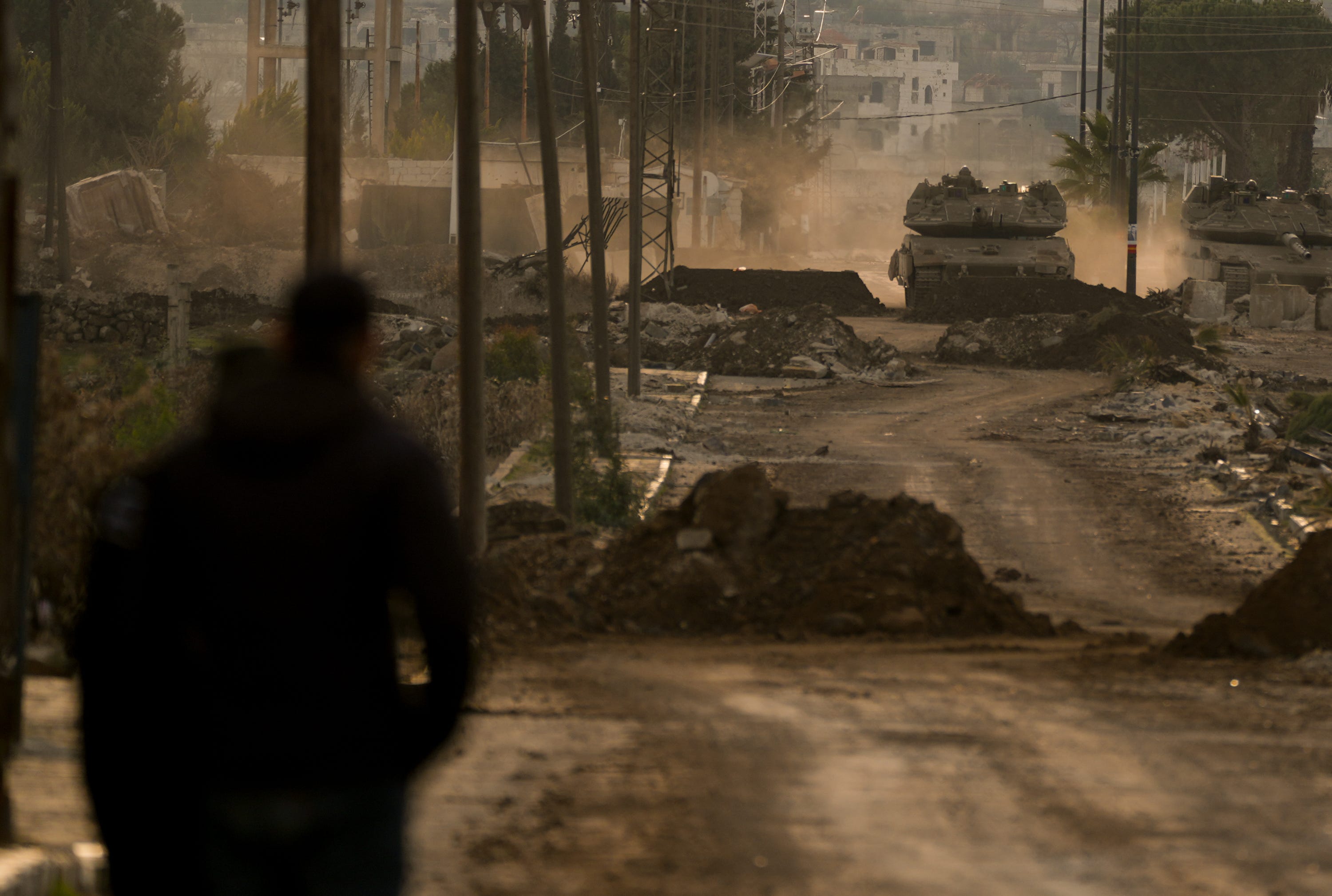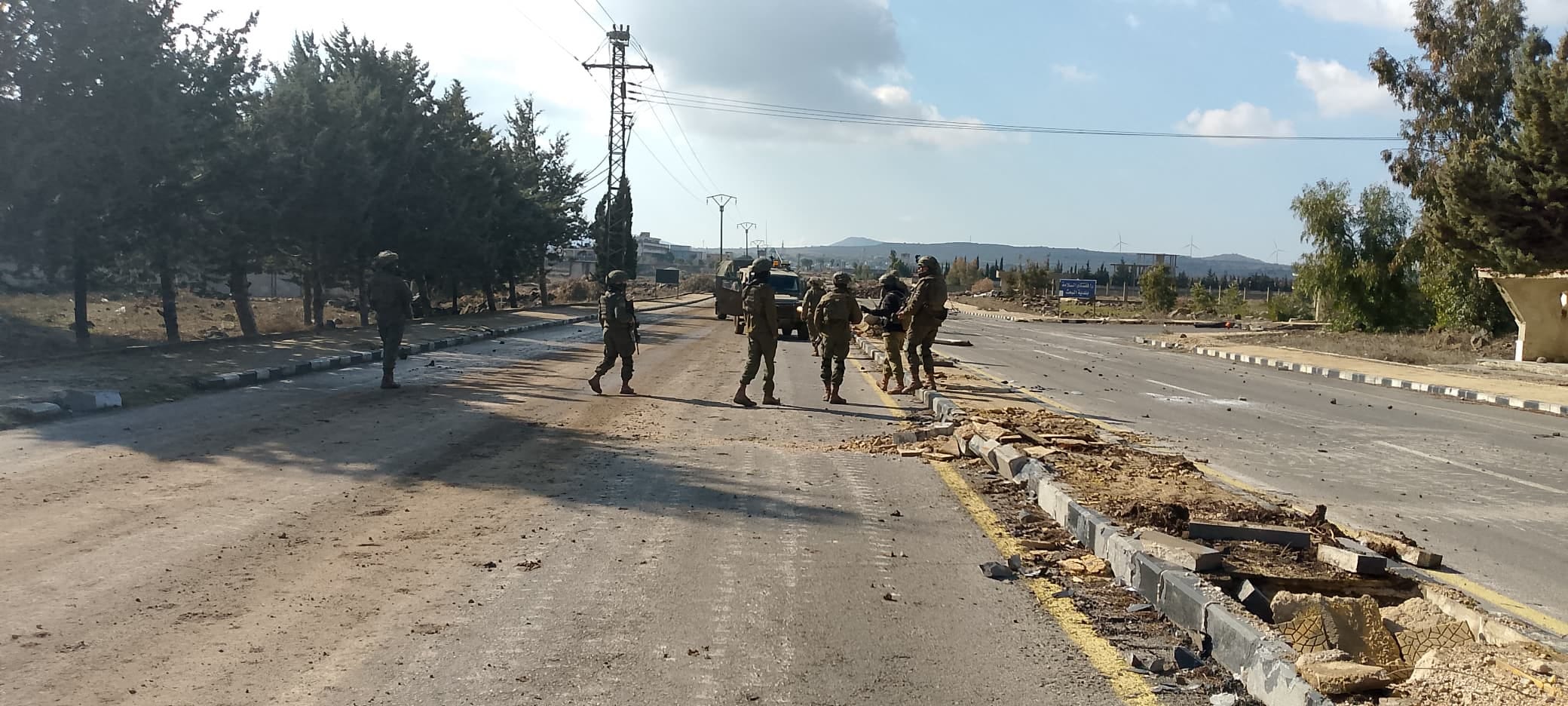Curfews, Roadblocks, House Raids—Israeli Military Entrenches Inside Syria
As Israel fortifies its presence in seized Syrian territory, residents say the new government in Damascus has abandoned them

AL-HAMIDIA, SYRIA—In the small Syrian village of al-Hamidia, some 50 kilometers southwest of Damascus, most homes, like that of sheep herder Abu Mo’ath, are built from black basalt stone, a hallmark of the region’s volcanic terrain. The air carries a scent of lavender and sage across the secluded rural landscape.
But over the past two months, life in the village has come to be defined by military occupation, with Israeli tanks and troops entrenching their presence on newly seized Syrian territory and laying siege to the area—destroying houses and critical infrastructure, erecting military outposts, restricting movement, displacing residents, and conducting arrests.
“We were displaced, then we returned home,” Abu Mo’ath, a 55-year-old father of five, told Drop Site News. “Our livelihood is hurt. Our lives are wrecked and our fate is unknown.”
Al-Hamidia is nestled in an internationally patrolled buffer zone in the Golan Heights between Syria and Israel. Israel seized most of the Golan Heights from Syria in the 1967 war, eventually building illegal settlements and annexing the area in 1981 in a move unrecognized by the international community—except for the U.S. after President Trump sparked global criticism in his first term by officially recognizing Israeli sovereignty over the Golan Heights in 2019. A demilitarized buffer zone was established in 1974 between the annexed region and Syria, with UN forces tasked with monitoring the area.
After the fall of Syrian president Bashar al-Assad in early December, Israel launched a massive campaign of airstrikes across Syria, preemptively targeting and destroying huge sectors of Syria's conventional military capacity, the very types of weapons and systems that all nations possess in order to defend their borders and sovereignty. The Israeli military also invaded deeper into Syrian territory, taking control of additional land in the buffer zone and beyond, including on Mount Hermon. Israeli officials have stated their intention to remain there indefinitely and troops in the area have continued to fortify their military presence, constructing runways and erecting military outposts and bases.
In the 14 Syrian villages that lie in this area, the lives of more than 35,000 people are now dictated by the Israeli military, with curfews, roadblocks, and house raids.
Over 50 families fled Al-Hamidia, one of the villages hardest hit by the Israeli invasion, alongside Kudna and al-Rawadi. Those who stayed have had to contend with life under Israeli occupation. Mo’ath, the eldest of Abu Mo’ath’s children, says the journey to his high school in the village Khan Arnabeh nearby has become virtually impossible. “Our usual route was just six kilometers, but now that Israel cut it off, we must travel 25 kilometers,” the 16-year-old said, adding that the journey has become too lengthy and expensive for many students. “A couple of my colleagues, particularly from Al-Samdaniya, missed their exams entirely.”
Video of the barrier set up by Israeli forces outside Abu Mo'ath's house with the Israeli diggers visible. Credit: Hoda Matar
Israeli officials have openly declared they will maintain a military presence in the region in the long term. “The Israel Defense Forces will remain … in the security zone … for an unlimited time period,” Israeli Defense Minister Israel Katz said in a video statement two weeks ago while standing on Mount Hermon. “We will not allow hostile forces to establish themselves in the security zone in southern Syria.”
Residents now find themselves under Israeli occupation with little support from Damascus or elsewhere. “We’re fearing another 1967, especially with the new government paying no attention to Quneitera,” Abdel Hakim Qutayesh, the former chief planning engineer in Quneitera, told Drop Site, in reference to the 1967 war when Israel captured parts of the Golan Heights. “This isn’t just a piece of land. It’s symbolic of Syria’s occupied territories. We raise our kids to be loyal to this land.”
But on the ground reporting from this region is scarce. Threatened by Israeli forces with expulsion and the demolition of their homes if any news or footage is leaked, local residents largely refrain from talking to the press. In the village of al-Rawadi, homes were burned or destroyed, driving many families to flee. Israeli troops have issued orders designating specific hours that residents can enter or exit the village. Soldiers record residents’ ID cards and phone numbers. Taking photographs and speaking to journalists are banned.
In Jabatha al-Khashab, a village known for dairy production, the Israeli military has designated specific grazing zones. The village chief told Drop Site that Israeli forces even sent digital maps via WhatsApp indicating permitted areas and times of movement. Herders who strayed beyond these zones have been arrested.
Last month, activist and lawyer Mohammed Fayyad was arrested in al-Hamidia along with French journalist Sylvain, and Syrian journalist Youssef Ghraibi as they filmed Israeli troops. “We were beaten and arrested on charges of filming sensitive areas and military sites belonging to the Israeli occupation army,” Fayyad told Drop Site. “Our mobiles, laptops and work equipment were confiscated, our hard drives were broken, and we were taken blindfolded and handcuffed to an Israeli investigation center, which I believe is the governorate building, based on the distance traveled.”
Under Assad, Syria was officially a part of the Axis of Resistance, the loose coalition of both nation-states and non-state actors in the Middle East who pledged to jointly oppose Israel. But unlike the other members—Hezbollah, Iran, the Houthis in Yemen, and the Islamic Resistance in Iraq—Syria did not launch attacks against Israel in response to the genocidal war against the Palestinians of Gaza.
Assad’s ouster was led by the powerful militant group Hayat Tahrir al-Sham (HTS) under its leader, Ahmed al-Sharaa, who has since been named Syria’s transitional president. Under pressure to respond to the massive Israeli aerial bombardment and taking of land in the Golan, Sharaa struck a diplomatic note. “Syria’s war-weary condition, after years of conflict and war, does not allow for new confrontations,” he said on December 14. “The priority at this stage is reconstruction and stability, not being drawn into disputes that could lead to further destruction.”
Last month, Sharaa carefully criticized Israel’s incursion into Syrian territory. “Israel’s advance in the region was due to the presence of Iranian militias and Hezbollah. After the liberation of Damascus, I believe that they have no presence at all. There are pretexts that Israel is using today to advance into the Syrian regions, into the buffer zone,” he said. “Syria remains committed to the 1974 Disengagement Agreement and is ready to welcome UN forces to restore conditions to their prior state,” he added.
With the new Syrian government unable or unwilling to confront Israel’s invasion and occupation, villagers in the border region have been left to fend for themselves.
Qutayesh, the former chief planning engineer in Quneitera, has been documenting the Israeli advances in the area since December 9, as well as what he described as the new central government’s “neglect of Quneitera.”
“For nearly two months, we had no governor, no police, and no security forces,” he told Drop Site. “Even aid didn’t arrive until January 26.”
The interim governor of Quneitera, Mohammad Al-Saeed, reiterated that the new Syrian government rejects Israel’s incursion in the area. “With the collapse of the former regime, Israel’s concerns of Iran and Hezbollah presence are no more,” Al-Saeed told Drop Site in an interview conducted via WhatsApp messages, adding that the Syrian government is holding no negotiations with Israel. “Our position is clear: Israel must withdraw immediately in line with international law.” He also stated that local leaders refused Israeli offers of "aid" and insisted on negotiating only through official Syrian channels.
Yet local residents say the aid they have received from Damascus does not come close to what is needed.
Abu Mo’ath said he had no choice but to sell his livestock. “I moved my family and animals to Sa’sa’, costing me three million lira (around $230). But the rent there was too high, and I have four children who attend schools, so we returned,” he said. “I ended up selling all my sheep—there’s no electricity to pump water for the livestock, and Israel took over our grazing lands.”
With water and electricity networks destroyed in Al-Hamidia, Qunietera’s Red Crescent provided water tankers for two days, but supplies were insufficient. Some villagers with private wells distributed water, but not enough to sustain livestock, forcing many to sell their herds before they died of thirst. Israel later allowed limited repairs to water and electricity infrastructure, with workers from outside the village permitted to enter twice last month.
Dr. Juma Younis, the head of the Quneitera Red Crescent, said his teams have been on the ground since the Israeli invasion in December. “We distributed food and emergency supplies, especially to families whose homes were burned or destroyed. We distributed water and tended to medical cases,” Younis told Drop Site. “But from now on, locals will need to manage on their own. The Red Crescent has used up all its supplies, including those left for emergency, and we have received no backup.”

Locals have set up WhatsApp groups and Facebook pages to share information. Yazan Abbas and his team started a WhatsApp group bringing together locals, right after the regime's collapse, to help internally displaced residents in Khan Arnabeh. “We are supporting four families who were forced to flee. Many others chose to move to Damascus and its suburbs to stay with relatives,” he said. “We offer shelters and warm clothes, especially since people left their homes with only the clothes on their backs.”
Another grassroots effort, set up by university student Mohammad al-Muteb, focuses on documenting Israeli violations, though getting media attention has been difficult. “Many journalists were too focused on celebrating the regime’s fall,” al-Muteb said.
In al-Hamidia, Um Mo’ath climbs the roof of her two-story home every morning to watch the Israeli bulldozers begin their work—clearing the earth, erecting concrete barriers, and getting closer to her home—before she returns to her land to tend the one cow that she owns. The 47-year-old makes cheese and yogurt and distributes to those who do not have livestock. “Our house has four rooms, but nowadays we all sleep in one room – the one closest to the main street,” she said.
“They’re building outposts, and I’m planting trees. My kids will continue to go to school here.”
This piece was published in collaboration with Egab.




More excellent reporting not seen in corporate mainstream media. Cheerleaders of genocide certainly hate Drop Site News for not concealing truth.
The sick Netanyahu is doing a fantastic imitation of Hitler's quest for Lebensraum.
Thank you DropSite for the clean news. Not the zionist controled bs we get
from the MSN.